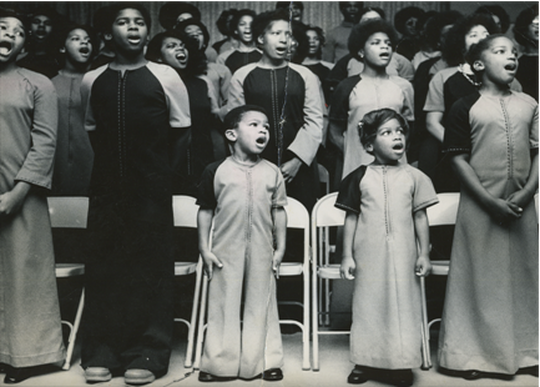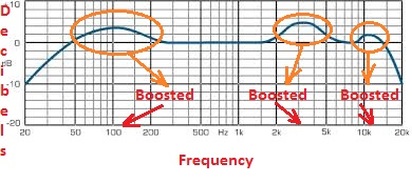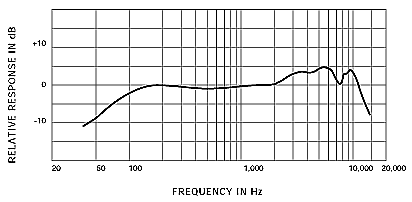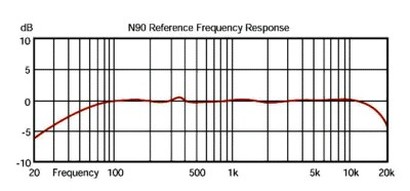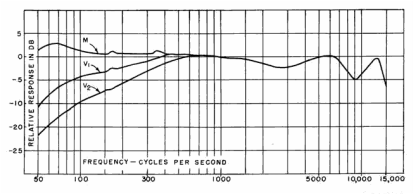THE VOICING CONCEPT
Everything has a voice.
Every person has a voice.
Each instrument has a voice.
Each speaker has a voice.
Each microphone has a voice.
Each mixing console has a voice.
Each piece of outboard gear (from EQ's to Effects processors) has a voice.
Each guitar's pickup has a voice.
Every guitar pedal has a voice.
Direct boxes have voices - take a passive direct box and compare it to an active one.
The room especially has a voice, and can change due to humidity or temperature, or the number of people in it, or the amount of glass, or absorptive material that resides in it.
Even instrument cables can have a voice according to their length and capacitance.
Not only do pieces of gear have voices, but how you use them can affect their voices as well.
The closer a cardioid microphone is to an instrument, the more "warmer" that instrument's voice will be due to proximity effect.
Cymbals have voices.
Drums have voices.
Identical instruments can have different voices according to what tree was used to build them, or the value of the capacitor in its tone circuit, or the distance each pickup is from it's strings.
A distortion pedal on a guitarist's pedal board can have a different voice according to how much power is left in its battery.
Heat can change an old fuzz pedal's voice because of the sensitivity of a germanium transistor to temperature, and this can happen if you are under hot stage lighting, and then the next night you may be gigging outside in the cold.
Guitar and Bass amplifiers have their own voices as well.
Try cleaning the potentiometers of an old vintage amp, and you may find its voice has taken a sheen to it that it may not have had since being on the showroom floor in 1965.
I think you may be getting the idea now. You may not have thought about it this way, but everything has a voice in music.
When mixing a band, think of everything as a choir. Can you hear every "voice" clearly? If not, you can change that voice to compliment all the other voices involved. Being aware of this can send the quality of your mix through the roof. This is the voicing concept in a nutshell.
We are going to take each entity and break down its' voice, and what you can do to change it to benefit your mix - I will also throw in some practical tips for the band as well. You can only mix what is given to you.
The following list will force you to make connections within your own mind. I'm not going to lay it all out plainly, because I want you to think deeply about each concept covered, and it'll stick in your brain easier, and more surely. I'm not going to lay out an exhaustive list for each instrument, but I want to bring out some concepts to get you thinking. We are no longer going to be punching in the dark for a good mix. We are going to connect this time!
Kick Drum
Snare Drum
Toms
Cymbals
Bass Guitar
Electric Guitar
Keyboard
Check out frequency response (dark source, brighter mic. bright source, darker mic):
Every person has a voice.
Each instrument has a voice.
Each speaker has a voice.
Each microphone has a voice.
Each mixing console has a voice.
Each piece of outboard gear (from EQ's to Effects processors) has a voice.
Each guitar's pickup has a voice.
Every guitar pedal has a voice.
Direct boxes have voices - take a passive direct box and compare it to an active one.
The room especially has a voice, and can change due to humidity or temperature, or the number of people in it, or the amount of glass, or absorptive material that resides in it.
Even instrument cables can have a voice according to their length and capacitance.
Not only do pieces of gear have voices, but how you use them can affect their voices as well.
The closer a cardioid microphone is to an instrument, the more "warmer" that instrument's voice will be due to proximity effect.
Cymbals have voices.
Drums have voices.
Identical instruments can have different voices according to what tree was used to build them, or the value of the capacitor in its tone circuit, or the distance each pickup is from it's strings.
A distortion pedal on a guitarist's pedal board can have a different voice according to how much power is left in its battery.
Heat can change an old fuzz pedal's voice because of the sensitivity of a germanium transistor to temperature, and this can happen if you are under hot stage lighting, and then the next night you may be gigging outside in the cold.
Guitar and Bass amplifiers have their own voices as well.
Try cleaning the potentiometers of an old vintage amp, and you may find its voice has taken a sheen to it that it may not have had since being on the showroom floor in 1965.
I think you may be getting the idea now. You may not have thought about it this way, but everything has a voice in music.
When mixing a band, think of everything as a choir. Can you hear every "voice" clearly? If not, you can change that voice to compliment all the other voices involved. Being aware of this can send the quality of your mix through the roof. This is the voicing concept in a nutshell.
We are going to take each entity and break down its' voice, and what you can do to change it to benefit your mix - I will also throw in some practical tips for the band as well. You can only mix what is given to you.
The following list will force you to make connections within your own mind. I'm not going to lay it all out plainly, because I want you to think deeply about each concept covered, and it'll stick in your brain easier, and more surely. I'm not going to lay out an exhaustive list for each instrument, but I want to bring out some concepts to get you thinking. We are no longer going to be punching in the dark for a good mix. We are going to connect this time!
Kick Drum
- Kick drum size. The bigger the drum, the lower the voice. A 24" kick is gonna be able to put out a lot more low end than a 20". This is because of more surface area used in which the drum is moving air.
- The type of head used on a kick drum can affect its' sound as well. An Aquarian head can sound way different than a Remo.
- Tuning your kick can majorly affect its' voice according to what you do with it. You may tune the beater head a little different that the front head to kill resonance. Or you may find tuning really loosely gets you where you are wanting to go.
- The type and amount of padding in a kick drum can turn it from a "boing" to a "boom."
- Leaving on the front head can cause standing waves within the drum, whereas leaving it off, can cause the microphone within to capture more voices around it due to "bleed."
- Place a kick drum on carpet and you'll get more boom. Place it on a hard surface, and you'll get more snap.
- What kind of beater do you have on the kick pedal? If you want less "click," a felt beater would be good. If you need more attack, than a wood or plastic beater would be good.
- Mic position. Closer to the beater head = more attack. Further from it = more boom.
- Kick drum mics. Each has its' own voice.
- Lube that kick drum pedal. Squeak. Squeak.
- Polarity switch can change its voice.
Snare Drum
- Tuning, tuning, tuning. Tune to the predominate key of the set.
- Snare wire. The more the wire, the more the sizzle.
- Open snare vs Muted Snare - ye old billfold trick. Moon gels.
- Kill "ring" by tuning one head a little higher/lower than the other.
- Head types - Evans Dry will sound different than a Remo Pinstripe
- Snare size. Depth=depth.
- What is the snare made out of? Wood, metal, plastic? Each has its own voice. Types of wood yields different tones.
- Where is the drummer hitting the snare? Find the place to hit it where the purist tone happens.
- Set gate with white noise running into it. The snare activates the key of the gate. Blend white noise to taste for each snare hit.
- Drum Trigger. Snare Sample. Blend to taste.
- Wood hoops sound glorious for rim shots.
- SM-57 is the standard mic, but an AT Pro37 gives power.
- High pass filter on a snare - good to keep the kick drum's low end from sneaking in to the snare mic.
- Plate verb is a good thing for snares.
Toms
- Remo Pinstripes are hard to beat. Pinstripe clear sounds better than pinstripe ebony. Ebony series lasts longer but are darker. Evans are more fashionable, but not necessarily better.
- Change those heads on a regular schedule. The sound of fresh heads tuned well beats hitting tupperware lids - all day.
- Tom sizes. I love the sound of a 10" tom tuned right. pooooooom!
- Tom Woods. Different = different.
- Tuning, tuning, tuning.
- Compression for more sustain (if you set it right).
- Lay off of the gates. No gates. Ever.
- Surgical tubing ran from the drummer's mouth to the vent hole on a tom makes for a fun and inspiring time. Tone changes with air pressure.
- Mic'ing on-axis can yield brighter tones; off-axis - darker tones.
- 80hz boost (conservatively) can help give some "roundness" to toms.
Cymbals
- Spend the money for better cymbals. Cymbals come across too sizzly? Zildjian K Dark can sound very purdy. Meinl - Sooo nice. Cymbal type, size, and brand can all make a big difference. If possible, only buy cymbals you can go and try personally.
- Piece of masking tape can help with too much sizzle.
- Keep them on felt. They'll last longer. No weird clangy-ness (is that even a word?).
- Closer the mic, the more immediacy and power to the cymbals.
- Don't mic the hi-hat. It'll bleed well enough without your help...unless you need to mic it! Ha!
- Clean the 20 years of filth off of them with a good brass cleaner.
- Never heavily compress your overhead mics. Keep them open and clean. Low Ratios. Soft Knee. Conservative compression.
Bass Guitar
- If it's an active bass, has a fresh battery? Probably not.
- Most bass signals go direct. Some dudes like the direct/mic'd combo. Sometimes it is helpful - others times it just adds mud.
- A little overdrive goes a long way sometimes. Yes, like a SansAmp Bassdriver DI, or an EBS Overdrive pedal. Just a little.
- Bass intonation? Is the bass's intonation good? It's almost never right.
- Pickup Height.
- Is the bass tuned?
- Fret buzzing?
- Direct box or amp with direct out.
- Keep cable length to a minimum.
- The longer the cable, the more capacitance and darker the tone.
- Make sure frets are in good shape.
- Flat wounds can sound glorious.
Electric Guitar
- Pedals - A massive amount of guitar voicing options.
- Less is more in regards to playing. Let notes be extremely expensive.
- No reverb during fast songs, unless you/they would like to throw mud on everything.
- Short guitar cable.
- Place the amp in an isolation cab, booth, or room. Run your signal from pedalboard with a line driver or boost to handle long cable runs.
- Tube amps will always sound better.
- Carefully adjusted Shubb capo, or the G7th won't throw a guitar sharp like a Kyser or a Dunlop.
- Keep away from heavy metal guitar god amplifiers. Hard to beat a Fender Deluxe Reverb or something similar. I play a Sovtek Mig50h and she's glorious. If in a church setting, try and find a place in which you can crank your amp during your worship set. For my church, we built 2 small iso booths under the stage that have been acoustically treated. Now we can crank our amps into all tube bliss-glory and get the tone we want without blowing out the congregation.
- String type affects tone. Nickel - Warmer and balanced. Stainless - Crispy and brighter. Polymer Coated - Less sustain but will last longer. More expensive though.
- String gauge. Bigger is warmer. Smaller is brighter. Dark sounding guitar with P90's - smaller gauges. Telecaster too bright, go to thicker strings.
- Bone or metal nut = more sustain than a plastic nut.
- Bridge/Saddle Material. Some folks swear by brass, others stainless, etc. If you're not happy, find what works. Be Pro-Active.
- LSR roller nuts are cool.
- Schaller locking tuners are rad. Sperzels are cool too.
- Capacitor changes in tone circuit. Custom voice your guitar!
- 250k pots for Telecasters, Strats, etc. 500k pots for Jazzmaster or P90 based guitars & Humbuckers. No rules here. Tune by ear. I once had a guitar that was way too bright with 500k pots...moved to 250k and thicker strings. Problem solved.
- The secret of the p90 pickup - Get them closer to the strings than what you are comfortable doing with any other pickup. Not too close cause you could kill sustain...but closer than usual.
- Place a plate of metal under the neck pickup of a Telecaster. Helps a lot most of the time.
- Fret buzz. Some dudes love those strings slammed to the fretboard, but it'll usually sound terrible.
- The farther the string is from the neck, the better the tone usually - as long as it isn't ridiculous.
- One mic is great, 2 can be better. Watch for phasing issues. You can use a mic combiner for this purpose with a blend control. Audio Technica makes one.
- Clean the fretboard of your guitars. Yes, this can make a big difference in purity of tone with guitars.
- Make sure frets are in good shape. You can buy a new neck for the same price as a fret job will cost you...unless of course you are rocking something really vintage. Mighty Mite turns out a great neck for a fair price.
- Soldering the ball end of the treble strings can keep them from cinching as bad. A labor of love indeed. Stretch- retune, stretch-retune.
- Mechanical Pencil rubbing in a guitar's string nut slot will keep the string from catching.
- Different brands and types of pickups can change a guitar's voice. Different magnet types and coil wire types can too. Playing on the neck pickup of a verse, and then switching to the bridge pickup during a chorus can give the biggest parts of the song some drive and movement.
- The number of windings in a pickup can change its voice.
- The person who wound the pickup can change its voice.
- Scatter wound - Wound by machine? Wound by hand?
- Changing each pole piece's height can make a big difference in balancing out chords. Muy Importante. Play open chord & listen for any strings that are too strong or that you can't hear. Adjust pole pieces accordingly.
Keyboard
- A quality direct box can help lift the "film" off of its' tone. Don't go cheap with direct boxes on keys.
- Keep strain relief on cables from the keyboard output jack. The 1/4" jacks can come unsoldered from the the component board because of the constant weight. I've seen keys go muffled sounding because of connection issues.
- Run MIDI to another module or computer to blend tones with more realistic piano sounds or greater pad sounds. Or, blend the two - whatever two it is.
- For a busy mix, sometimes a high pass filter can help on a keyboard channel.
- Super glue works great for Yamaha broken keys on Motifs, doesn't work at all on Roland keys. Ask me how I know.
- Mics and mic position. Need deeper, move towards the bass end. Need brighter - move to the treble strings side. Have pianist play. Do you hear any part of the piano that isn't represented well by the mics?
- Smaller diaphragm condensers are more precise and faster in their response.
- Keep mics pointing away from stage monitors.
- Piano should be well maintained by someone who knows how. This is more than just tuning.
- No rapper grip - yea dawg.
- Closer to the voice, more warmth. Further away - less warmth & more noise.
- Mic type can affect vocals.
- The Shure Beta 87 is a GREAT live vocal microphone. It'll cut through a mix without sounding too bright.
- Shure SM-7 - beautiful vocal mic.
- The SM-58 is the live standard for a reason.
- Supposedly, the SM-57 & SM-58 are the same mic capsule with different grills. Frequency responses look slightly different. Probably from different grills.
- Compression. Tame those peaks. Adjust output Gain to the same amount as you are compressing. 2.5:1 ratio will do it most of the time.
- Multing & Parallel processing can be quite effective. Heavy compression on one channel, and none at all on the other. Blend to taste.
- High Pass filter. Nothing good is happening below 100hz for a vocal. Mostly rumble and handling noise.
- Dark plates can sound great for vocals.
- Always tame the highs on the effects return with a channel EQ or within the unit in regards to reverb and/or echos.
- No multi-colored microphone grill muffs, unless you want it to sound as if you have your hands over your ears, and you look like you are in 1992.
- Big bodied - big sound. Small bodied - small sound.
- Almost all acoustics can benefit from a cut in the 800hz range. Not a rule, but most of the time.
- Always use a direct box or an acoustic guitar preamp with an XLR out. Gotta get the impedance right for it to sound good.
- L.R. Baggs passive i-Beam pickup is great. No batteries. You can choose your own high quality preamp and not be stuck with theirs.
- Fishman makes fine pickups.
- String type and gauge makes a big difference.
- Keep fresh strings on it. Not as in an hour ago, but as in a week ago. Stretch them until they stop going flat. Stretch - retune. Stretch - retune.
- String types to change the voice: Bronze - Bright, but go dull quickly with age. Phosphor Bronze - Warmer. Stays legit longer because of the alloy. Silk and Steel - I used to be a big fan of silk & steel when I was doing finger style picking. Sounds beautiful when new. They wear out quickly. Polymer Coated (like Elixir) - I love the sound of them. The tone stays the same forever it seems. Not great for heavy handed strummers. Chunka Chunka Chunka!
- I never met a Martin Dreadnaught that I thought sounded great live...especially mic'd. Oh the heresy! Too much low-mid. On the other hand, some of their smaller bodied and OM styled guitars can sound amazing live.
- Dynamic - takes a decibel whoopin. Keeps coming back for more. Preferable for loud sources.
- Condenser - usually brighter and more detailed. More sensitive. Usually picks up more stage noise.
- Ribbon - darker. Great for guitars, female voices, etc. Not good for really loud sources. Phantom power will kill them. Be careful not to have phantom going to a ribbon mic...unless of course it's a Royer or something similar.
MATCH THE VOICE OF THE MICROPHONE TO THE VOICE OF THE INSTRUMENT/SOURCE.
Check out frequency response (dark source, brighter mic. bright source, darker mic):
**Cool Tip Alert: Have all of your background vocals on dynamic microphones (like a Shure SM-58 or similar), and have the lead singer sing in a condenser microphone for live work (like a Shure Beta 87a/c). The condenser will tend to be a little brighter and more detailed, while the dynamic microphones will be a little duller typically. This will place the sound of the background vocals right under the lead vocal, and will almost mix itself. In this technique, you are essentially voicing your vocal section to work together!
The Environment
Temperature
The colder the temperature, the more an instrument will tend to go sharp. The hotter the temperature, the more an instrument will tend to go flatter. In cold weather, I have noticed that instruments can become a little more strident with a sheen tonally speaking.
Humidity
In very humid climates, I have noticed the tendency of instruments to sound duller...especially acoustic instruments and drums. I used to live in West Texas in desert country, and I never thought of this. I had heard about this phenomenon in recording articles I read and such, but had never experienced it until I moved to south Louisiana. 100% humidity in the summer & it feels like you are breathing water. It can wreak havoc on the tone of toms.
Yes, your environment can affect the voices of instruments; thus changing your mix.
The colder the temperature, the more an instrument will tend to go sharp. The hotter the temperature, the more an instrument will tend to go flatter. In cold weather, I have noticed that instruments can become a little more strident with a sheen tonally speaking.
Humidity
In very humid climates, I have noticed the tendency of instruments to sound duller...especially acoustic instruments and drums. I used to live in West Texas in desert country, and I never thought of this. I had heard about this phenomenon in recording articles I read and such, but had never experienced it until I moved to south Louisiana. 100% humidity in the summer & it feels like you are breathing water. It can wreak havoc on the tone of toms.
Yes, your environment can affect the voices of instruments; thus changing your mix.
Room Acoustics
Have you ever been in a room of a ton of people all talking at the same time and it sounds like chaos? This is basically what had happened to me several years ago when I was running sound for a university campus ministry around 1999. I was placed in a room with absolutely no absorptive material whatsoever. There was a full band rocking it out, and there was absolutely nothing I could do, but just do my best. Tile floors. Wooden ceiling and stage. Brick walls with glass windows all the way down. Glass walls behind me. Metal chairs. Blaring guitar amps. Stage monitors. Full drums with no shield. Mediocre band. NIGHTMARE.
All running through a bare bones Peavey mixer with no mutes, no outboard gear to speak of, and a pair of Peavey SP-2's.
After about a year of this, the ministry director told me a new budget had been approved to do some upgrades to the building. He said, "I am thinking about getting nice thickly padded chairs, and carpeting the room...and then after that, upgrading our sound system that you can choose. What'cha think?" Yes Indeeeeeed. There wasn't enough money there to do appropriate text book acoustic treatment, but hey, it was better than nothing, and improved the situation by a mile. I was grateful and thankful.
Listen, you don't need a world renowned acoustician to treat your room. But, you yourself can change the "voice" of your room by being smart and treating it yourself. Once our Room Acoustics page is built, you can learn a lot about it yourself, and improve your situation much easier. In the mean time, just know that the room you are mixing in has a voice, and that you can improve your mix by changing that room for the better.
Have you ever been in a room of a ton of people all talking at the same time and it sounds like chaos? This is basically what had happened to me several years ago when I was running sound for a university campus ministry around 1999. I was placed in a room with absolutely no absorptive material whatsoever. There was a full band rocking it out, and there was absolutely nothing I could do, but just do my best. Tile floors. Wooden ceiling and stage. Brick walls with glass windows all the way down. Glass walls behind me. Metal chairs. Blaring guitar amps. Stage monitors. Full drums with no shield. Mediocre band. NIGHTMARE.
All running through a bare bones Peavey mixer with no mutes, no outboard gear to speak of, and a pair of Peavey SP-2's.
After about a year of this, the ministry director told me a new budget had been approved to do some upgrades to the building. He said, "I am thinking about getting nice thickly padded chairs, and carpeting the room...and then after that, upgrading our sound system that you can choose. What'cha think?" Yes Indeeeeeed. There wasn't enough money there to do appropriate text book acoustic treatment, but hey, it was better than nothing, and improved the situation by a mile. I was grateful and thankful.
Listen, you don't need a world renowned acoustician to treat your room. But, you yourself can change the "voice" of your room by being smart and treating it yourself. Once our Room Acoustics page is built, you can learn a lot about it yourself, and improve your situation much easier. In the mean time, just know that the room you are mixing in has a voice, and that you can improve your mix by changing that room for the better.
Hey Guys, Spread Out!
Most bands play in the same frequency area. You can improve the voice of any band by suggesting that they spread out their parts. The keys person can play closer to the treble side, one guitarist can play with a capo up higher and transpose, or play counter-melody, while the other guitarist can play without a capo sticking with chords, and the background vocalists can learn how to sing parts rather singing unison the whole time. These types of simple things can really improve the overall sound of a band. Remember, if you think of a full band as a choir - meaning each instrument is a voice, you can then concentrate on making sure that every part is heard clearly.
Lighting, Yes That's Right
This next part really belongs in our Psychoacoustics page, but I would like to briefly mention that lighting can mentally affect the overall listening experience of the service. You can take a group of people and place them in a dimly lit environment, and they will say that the sound of the band was better. Lighting can affect the overall sound of your mix (mentally)! Logically and technically, this is wrong...but most of those listening, "hear" with their eyes just as much as they do with their ears. Also, traditional non-LED type lighting (with real bulbs) can really heat up a stage. Heat can have a tremendous effect on the sound of almost all acoustic instruments. Heat can also have an affect on certain types of electronic devices as well. For instance, some of the older Fuzz Face pedals have germanium transistors that can change the tone of the circuit according to how hot they get (or at least Eric Johnson claims this).
This next part really belongs in our Psychoacoustics page, but I would like to briefly mention that lighting can mentally affect the overall listening experience of the service. You can take a group of people and place them in a dimly lit environment, and they will say that the sound of the band was better. Lighting can affect the overall sound of your mix (mentally)! Logically and technically, this is wrong...but most of those listening, "hear" with their eyes just as much as they do with their ears. Also, traditional non-LED type lighting (with real bulbs) can really heat up a stage. Heat can have a tremendous effect on the sound of almost all acoustic instruments. Heat can also have an affect on certain types of electronic devices as well. For instance, some of the older Fuzz Face pedals have germanium transistors that can change the tone of the circuit according to how hot they get (or at least Eric Johnson claims this).
Equalization
One of the fastest and most effective way of changing the voice of an instrument, is EQ. If you've exhausted your mic choices and mic placement, and you are limited in the amount of instruments you can switch to, then it could be time to EQ it. Check out our EQ page to learn more about this.
One of the fastest and most effective way of changing the voice of an instrument, is EQ. If you've exhausted your mic choices and mic placement, and you are limited in the amount of instruments you can switch to, then it could be time to EQ it. Check out our EQ page to learn more about this.
Instrument Selection / Instrument Voicing
I am a guitarist. Sometimes a song or a set of songs will call for more brighter and driving guitar parts. In that case, I may choose to play my Telecaster. Or sometimes you may make it past a couple of rocking songs and then move to a more ambient piece, and from there, I would choose a darker toned guitar. Or another way to look at it, is if my lead guitarist has a brighter sounding guitar, I may choose a warm sounding acoustic guitar, or an electric guitar with p90 pickups. The concept is that you choose your instrument and musical parts to compliment the rest of the band, and/or to communicate the overall message and feel of the song. Really great drummers do this as well. They may use a brighter and more aggressive snare for one type of song, but may switch mid-stream to a deeper sounding snare to compliment a slower chilled out selection. This is called instrument voicing.
I am a guitarist. Sometimes a song or a set of songs will call for more brighter and driving guitar parts. In that case, I may choose to play my Telecaster. Or sometimes you may make it past a couple of rocking songs and then move to a more ambient piece, and from there, I would choose a darker toned guitar. Or another way to look at it, is if my lead guitarist has a brighter sounding guitar, I may choose a warm sounding acoustic guitar, or an electric guitar with p90 pickups. The concept is that you choose your instrument and musical parts to compliment the rest of the band, and/or to communicate the overall message and feel of the song. Really great drummers do this as well. They may use a brighter and more aggressive snare for one type of song, but may switch mid-stream to a deeper sounding snare to compliment a slower chilled out selection. This is called instrument voicing.
Effects Choice
You may decide to use a plate reverb on snare and vocals for a faster and more aggressive song, and then could switch to a hall reverb for a more subdued part of the set. You may choose to have a timed delay for a majestic part of a song, and then switch to a faster echo on the other parts. Guitarists may use overdrive during big chorus parts, and then switch over to a verb, delay, or tremolo for verses.
You may decide to use a plate reverb on snare and vocals for a faster and more aggressive song, and then could switch to a hall reverb for a more subdued part of the set. You may choose to have a timed delay for a majestic part of a song, and then switch to a faster echo on the other parts. Guitarists may use overdrive during big chorus parts, and then switch over to a verb, delay, or tremolo for verses.
Movement
Check this song out. It's one of my favorites:
Check this song out. It's one of my favorites:
This is a perfectly executed song in regards to the voicing concept of "movement." You have these long sustaining chords that would get very old very quickly had it not been for the movement brought about by the drums mixed brilliantly in the background. The drums are there to provide movement, and yet don't take away from the rest of the song, nor do they step on anything else presented. The drums keep the song moving right along and provides a solid footing for the rest of the band. Two of the most classic "movement" type of instruments are drums and acoustic guitar. This song has a little bit of both. Very nicely done.
Melody & Counter Melody
Do you have someone important to you, or a famous person that you can remember their voice almost perfectly? What makes that voice more memorable than the next? That's what melody & counter melody does. It makes the voice of the song memorable. No one leaves a concert humming the snare drum part. The melody rules the song, and everything else is to provide support for it. Nothing is worse than someone singing a verse of a song, and the lead guitarist is there shredding a blazing guitar solo at the same time. The band has to be very intentional about bringing songs with rich melody to the table, and your job as the engineer is to feature that in the mix. Find the melody and support it - both musically and mixing wise.
Do you have someone important to you, or a famous person that you can remember their voice almost perfectly? What makes that voice more memorable than the next? That's what melody & counter melody does. It makes the voice of the song memorable. No one leaves a concert humming the snare drum part. The melody rules the song, and everything else is to provide support for it. Nothing is worse than someone singing a verse of a song, and the lead guitarist is there shredding a blazing guitar solo at the same time. The band has to be very intentional about bringing songs with rich melody to the table, and your job as the engineer is to feature that in the mix. Find the melody and support it - both musically and mixing wise.
Just For the Band: The Drummer Is the Leader, and the Leader Is the Band Director
Have you ever heard someone's voice that is really easy to listen to, memorable, and powerful? This is the effect a band's voice can have by doing something very simple. Realize the drummer should be the leader, and turn your focus on what they are doing. I understand that this is not practical if the drummer is terrible. Sometimes you have who you have, but when the drummer is really good, if you play to the drum hits, and time what you are doing to what he/she is doing, this will take the power of your voice as a band to a whole other level. This is called playing together. Being on the same page.
[ Be Intentional. Pay Attention ] - A message for the band and the mix engineer!
Watch this video. I've never really been a big fan of Jesus Culture, but I will say that this video is super impressive. Not for the song (hard to beat a Keith Green tune), but for how the band is watching one another, listening, and paying attention. My favorite part is at the very end - how the dude on piano watches the worship leader to see where she's going to go, and then realizes she's done and gently lays his headphones down. Brilliant!
Have you ever heard someone's voice that is really easy to listen to, memorable, and powerful? This is the effect a band's voice can have by doing something very simple. Realize the drummer should be the leader, and turn your focus on what they are doing. I understand that this is not practical if the drummer is terrible. Sometimes you have who you have, but when the drummer is really good, if you play to the drum hits, and time what you are doing to what he/she is doing, this will take the power of your voice as a band to a whole other level. This is called playing together. Being on the same page.
[ Be Intentional. Pay Attention ] - A message for the band and the mix engineer!
Watch this video. I've never really been a big fan of Jesus Culture, but I will say that this video is super impressive. Not for the song (hard to beat a Keith Green tune), but for how the band is watching one another, listening, and paying attention. My favorite part is at the very end - how the dude on piano watches the worship leader to see where she's going to go, and then realizes she's done and gently lays his headphones down. Brilliant!
Just For The Engineer
You are in the band. The mixing console and everything attached to it is your instrument. Mediocre engineers will just mix and get through the set.
A great engineer will "play" his/her mixing console with the band!
Always be one step ahead. Always anticipate what is coming next, and throw in the right part at the right time!
You are in the band. The mixing console and everything attached to it is your instrument. Mediocre engineers will just mix and get through the set.
A great engineer will "play" his/her mixing console with the band!
Always be one step ahead. Always anticipate what is coming next, and throw in the right part at the right time!
|
|
